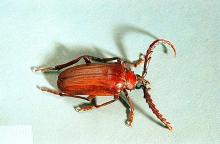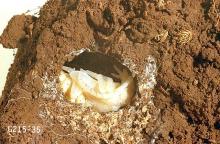Prionus californicus
Pest description and crop damage Adult beetles are brown, 1.5 to 3.5 inches long and 0.75 inch wide. Antennae are long and sweeping and may be saw-like. Larvae are legless white grubs 0.25 to 3 inches long. The head is brown with strong protruding jaws. Adults emerge in July and lay eggs near the base of the hop plant. Adults live about 4 weeks, and do not feed. Larvae live in the soil for 3 to 5 years, feeding on hop roots. Larvae feeding results in decreased nutrient uptake, water stress, and reduced plant growth, and heavy infestations will cause wilting, yellowing, and the death of one or more vines, or the entire plant. Adult males are strongly attracted to a female-produced mating pheromone that is commercially available for monitoring presence of adult beetles.
Management-chemical control
- ethoprop (Mocap EC) at 3 lb ai/A on baby hops (nonproducing) or producing hops. REI 72 hr. Group 1B insecticide.
- Baby hops, post-plant, pre-emergence: apply as a broadcast application immediately incorporated into the top 2 to 4 inches of soil using a disc or rotary cultivator, or as a broadcast or band application followed by 1 to 2 inches of overhead irrigation. If applied by band, apply in band at least 2 feet wide over the row.
- Baby hops, pre-plant: apply as a broadcast application and immediately incorporate into the top 2 to 4 inches of soil using a disc or rotary cultivator.
- Producing hops: apply in the spring after pruning, but before stringing, or post-harvest as a broadcast application immediately incorporated into the top 2 to 4 inches of soil using a disc or rotary cultivator, or as a broadcast or band application followed by 1 to 2 inches of overhead irrigation. If applied by band, apply in band at least 2 feet wide over the row. PHI 90 days. Make only one application per year. Do not apply more than 3.0 lb ai/A per year. Do not apply to saturated soil which increases runoff or to dry soils which decreases effectiveness.


